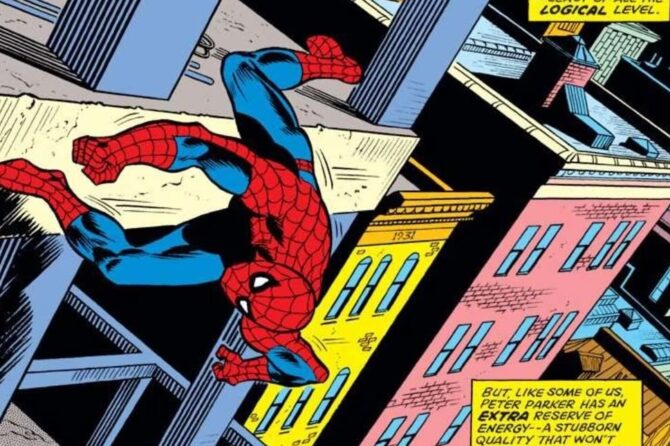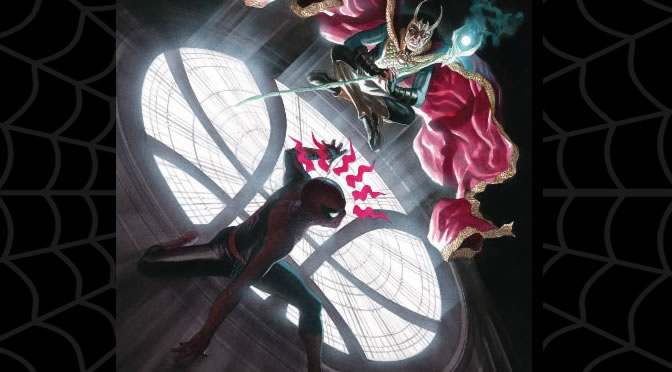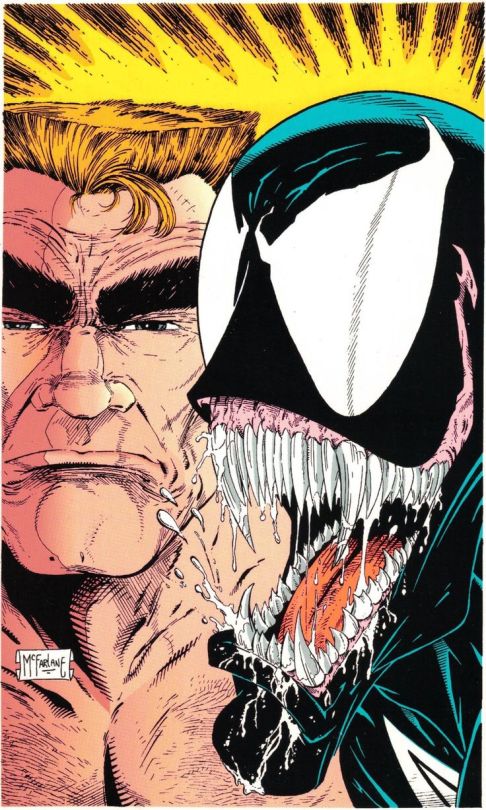
I’ve been thinking about covering underrated runs of Spider-Man comics, but with it being Batman day, it’s worth looking at one of the best Spider-Man writers’ contributions to the caped crusader. You might know his run on the Defenders. Or you might also be familiar with the humor comics he cowrote with Keith Giffen for artist Kevin Maguire, especially the bwahahha era of the Justice League. Less appreciated is his work on Batman. Part of it may be that he never had a run on the title, his legacy consisting of two Legends of the Dark Knight arcs, a 2002 graphic novel, four double-sized one-shots—two co-starring Spidey, and some scattered standalone material.
As he noted on his blog, his first published full-length comic was a Batman team-up. And it was predated by both an eight page short story in Detective Comics #489 , as well as the coloring book “The Mystery of the Million Dollar Joke,” which if you’re really interested is reviewed on Youtube. But let’s take a look at the regular comics.
“Creatures of the Night” Detective Comics #489
DeMatteis’ first standard Batman comic book adventure was an eight page lead story in Detective Comics on a familiar theme, pitting Batman against vampires, something we’ve seen in one of his first adventures against the Mad Monk and to great effect in the Red Rain series of Elseworlds graphic novels. It’s a shorter piece with Batman investigating a villain who seems to be a vampire, while annoyed by the interference of a mystic, but there’s enough room for a twist that goes beyond the binary of whether the killer is a vampire, and that still reveals much of Batman’s skeptical character.
DeMatteis writes three more stories for Detective Comics #493-495, but these starred Red Tornado and Black Lightning, so we can skip those.
B
“The Mystery of the Mobile Museum” Brave and the Bold #164
There are much worse ways to make a feature-length debut in comics than a Batman/ Hawkman team-up illustrated by Joseph Garcia Lopez. While it foreshadows his work on a different team-up for Marvel, it seems more like JMD’s work on the Defenders as the heroes are pit against a strange cosmic menace. The threat makes for some trippy visuals, as the cosmic enemy has taken over a museum and turned into a floating fortress, but the stakes are raised when Hawkman’s wife is in danger. There’s a solid dynamic where Hawkman’s concern about his wife makes the situation worse, as he takes risks that he really shouldn’t.

Superman: Speeding Bullets
The basic conceit of this one-shot is that it merged the Batman and Superman mythos, featuring a Clark Kent adopted by the Waynes. That makes it a bit tough to categorize; is this more of a Batman comic or a Superman story? It rated 68th in CBR’s best of Superman list, although however you classify it, it was quite good and arguably JMD”s best Batman related work. It’s an accessible merger of the two worlds, that also works thematically. The obsession with bullets fits both Batman and Superman, and we have a new take on the heroes as we cover Batman learning to be Superman, and a Superman who sees solidarity with bats, the flying creatures that seem to have X-ray vision. Eduardo Baretto’s art is fantastic, capturing the crime-laden darkness of Gotham City very well (quite reminiscent of David Mazzuchelli’s Batman: Year One) while paving the way for the emergence of something new. The villain is great as the amalgam of DC’s greatest heroes faces a Lex Luthor who has gone quite mad in the aftermath of a chemical accident.
A+
Batman/ Two Face: Crime & Punishment
This one-shot meant to tie in to Two-Face’s appearance in Batman Forever hits some familiar themes from DeMatteis’ Spider-Man work, with child abuse, a Dostoevsky reference in the title, a key character dealing with the legacy of a difficult father, and a member of the rogues gallery pushed further than ever before by personal demons. Scott McDaniel’s exaggerated fits the chaotic mood, and the tortured psyche of the villain. Two-Face is the main character here, with Batman’s arc primarily limited to determining how to defeat one of his greatest enemies, and we get a sense of a Harvey Dent off the deep end, pissed off by modern society. The ending is a bit unearned, as it’s something we’ve seen so many times before in the stories with these two characters, and large number of innocent casualties are largely overlooked when that should matter more than one person’s breakdown.
B

“Going Sane” Legends of the Dark Knight #65-68
An early genesis for Kraven’s Last Hunt was DeMatteis trying to pitch a story in which Batman is believed dead in the aftermath of a battle with one of his greatest enemies. He’s able to explore that here with the Joker, but instead of just focusing on the effects of Batman’s disappearance and recovery, he looks at what it means for the Joker to no longer have anyone to perform for. It was rated the 63rd best Batman story by CBR readers, a decent showing for an obscure 1990s arc. DeMatteis said “that may be my absolute favorite of all the mainstream superhero stories I’ve written.”
Many writers have covered Batman and the Joker’s first encounter; DeMatteis tackles a different milestone with Batman and the Joker’s third encounter as Batman tries to take a murderer who has faked death twice to justice. It’s early enough in his career that he hates the Joker but hasn’t quite gotten used to him, where the citizens of Gotham can see a clown without immediately thinking about the madman who has become as much of a local institution as the caped crusader.
Artist Joe Staton covers the Batman side of things quite well, in addition to tender romances with a Batman and the Joker who are ready to just give everything up. The scale of the story is hard to reconcile with the histories of the characters, as Batman and the Joker spend months out of the public eye, but it provides interesting arcs for both, as well as setting a rematch where they’re affected by their recent experiences, where the costs are greater than we’re used to.
A
Spider-Man/ Batman
This would be the story of most interest to Spider-Man fans, as DeMatteis reunites with his Amazing Spider-Man collaborator Mark Bagley, to showcase an adventure pitting the wall-crawler and the Dark Knight against the Joker and Carnage. It’s one of the best Carnage comics (not a shocker given that Bagley cocreated the character and DeMatteis wrote the best chapters of Maximum Carnage), and a reminder that JM DeMatteis cut his Spider-Man teeth on Marvel Team-Up, so a guy who got started with seventeen page team-ups could find much to explore in 48 pages. It’s a busy issue but it’s not crammed.
The main story’s been done before, as the heroes initially annoy one another and then inevitably come to work together and respect one another, but the combination of the two worlds makes for some interesting dynamics, as the Joker represents what Spider-Man fears most, and Carnage represents something just as nasty to Batman. There are some surprising intersections. Carnage is a bit of a Joker fanboy, and doesn’t really care one way or the other about Batman. Spider-Man finds himself out of his element in Gotham, a city that seems to be the worst of New York. The villains are connected by a new effort to lobotomize psychotics, which adds some thorny ethical issues into a standard superhero adventure. And there are some clever smaller moments, even if it’s something as simple as Batman getting freaked out when the Joker tries to bite him.
A

Batman/ Spider-Man: New Age Dawning
This is a rarity in intercompany team-ups, featuring a reunion from top-tier heroes who aren’t meeting for the first time, and have become familiar with one another. There’s an odd couple pairing between the serious and methodical Batman, and the more instinctual Spider-Man who is ready with jokes but wants to break the old patterns. Ras Al Ghul’s plan is a bit too apocalyptic for a 48 page special, although it’s certainly a threat worthy of bringing together Marvel and DC’s top heroes. Kingpin’s story is a bit different from what we’re used to in the supervillain team-ups, as he’s just doing what’s best for his sick wife, whose love for her difficult husband is paralleled with Talia Al Ghul’s love for her father.
B+
“Grimm” Legends of the Dark Knight #149-153
This arc covers something completely new for DeMatteis as he explores what it likes for Dick Grayson early in the partnership with Batman, when it’s conceivable that Bruce might just send him away to live with a different family, or that the kid might run away. The narrative works pretty well for Robin, as the dynamic duo face a fairy tale themed villainess Mother Grimm, who is different from the standard bad guys, and just stealing toys for her secret society of abandoned children. Her story intersects with something more familiar; a murder mystery involving one of the richest men in Gotham City. Artist Trevor Van Eeden tackles the childlike wonder of Robin in an abandoned amusement park, as well as the darkness of Batman’s usual life and the derangement underneath a seemingly silly lunatic.
B+

Batman: Absolution
DeMatteis’ Absolution graphic novel made IGN’s pre-Scott Snyder/ Tom King list of the top ten Batman stories. The painted art by Brian Ashmore makes for a gorgeous looking comic, that tackles difficult questions about whether heroes may be going too far in the name of justice, relevant in the year after September 11. The volume covers Batman’s decade long investigation into a terrorist bombing of Wayne Enterprises.
While some of JMD’s other stories spotlight the villains, this is mainly about Bruce Wayne, largely alone and cut off from familiar trappings. There’s no Robin, no Commissioner Gordon, and no Alfred, just Batman seeking justice and pushing himself to the limits psychologically and physically. The villains are largely new, a group of terrorists whose motives aren’t fully understood at first, which allows Batman to make some mistakes. DeMatteis avoids the clean answers, as we never do learn whether the skepticism is merited, and kind gestures hide ulterior motives. This is a story that works very well in the original graphic novel format, as the painted art would suffer as a mini-series or an arc of Legends of the Dark Knight punctured by cliffhangers and credits pages.
A
DeMatteis’ total work on Batman is the equivalent of 22 issues, which is enough to make a mark. He has also tackled Batman in guest-appearances in his runs on Spectre and Justice League, introduced a future version of Batman in Justice League 3000/ 3001, and written an animated version of the character in the Brave and the Bold animated series. His Justice League run included one of the most iconic Batman moments ever but his contribution to the character goes beyond that.
Looking at DeMatteis’ Batman work, there are some cliches and recurring themes that pop up. We see the power of the subconscious mind at work, and a Batman who is convinced that Bruce Wayne is the mask. There are probably too many references to the traumatic death of Bruce Wayne’s parents, and it doesn’t stop getting ridiculous when a mystery man takes off a mask and Batman’s mask is underneath it. Some of this may be a consequence of tackling self-contained stories where there isn’t much of an opportunity for ongoing subplots, so the material is mainly meant to be appreciated in isolation, rather than a DeMatteis fanboy reading it all over the course of a weekend.
The biggest takeaway is that the stories are always about something, as DeMatteis and a generally impressive array of artists raise some tough questions, which remain unanswered even if the bad guy’s been defeated and the immediate threat is resolved.










The first Spidey/Batman crossover is probably the best DC/Marvel collaboration there is imo. Better than Supes/Spidey even.
William, while I’m arguing that DeMatteis’ Batman work is overlooked, he certainly remains one of the best Spider-Man writers. With his Batman, it does seem that he’s constrained by writing all these self-contained stories, so that we don’t have longer arcs or things in one issue having reverberations later. These are things he was able to take advantage of in Spider-Man. Kraven’s Last Hunt was self-contained, but it was helped by the way it built on events in the regular comics (the death of Ned Leeds; Peter and MJ’s marriage.) And his Harry Osborn saga is one of the best mega-arcs in the Spider-Man comics.
I can’t actually say that he wouldn’t have been an even better fit for Batman, because we never did get to see what he would be like if he had two years on one of the bat-titles.
Hornacek, he is certainly underrrated as a funny writer. We’ve got the Frogman and White Rabbit issues of Marvel Team-Up and Spectacular Spider-Man, as well as his unconventional run of Justice League.
As much as JMD is known for dark and psychological stories, he proved again and again that he could do comedy. The Legion of Losers stories in Spec were comedy gold. I remember reading at the time sure that it was a fill-in writer, as I was convinced that JMD could only do serious stories.
I’ve heard the argument that DeMatteis is a better fit for Batman than Spider-Man, due to his darker style and focus on the psychology of his villains. I kinda disagree because there’s no reason Spidey stories can’t be dark and psychological, but it is true that he’s a great fit for Batman. Going Sane, to me, is possibly the best analysis of the Joker as a character, a great companion-piece to The Killing Joke (and without some of the more troubling content that story has!) In terms of the Batman/Spider-Man crossovers, I think the first one is a fun read just to see the two together, but the second one he did is just great as a story for both of the characters.